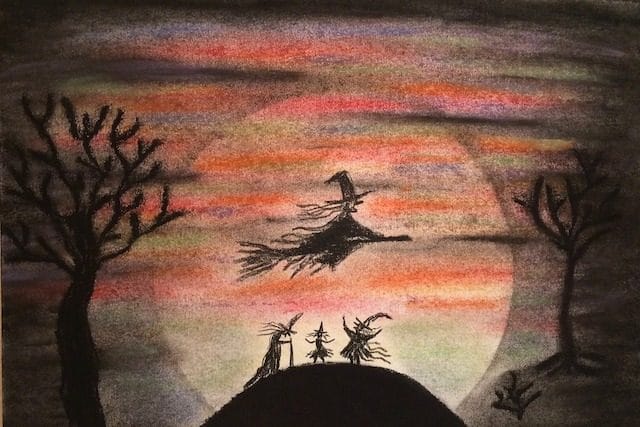Каждая эпоха, вероятно, считает себя достаточно просвещенной. Сегодня мы все, кажется, достаточно уверены в том, что знаем, как устроен мир, но мы все еще можем видеть примеры людей, постоянно верящих в какие-то невероятно глупые вещи. В будущем, весьма вероятно, люди будут писать статьи о сегодняшнем мире и обо всех глупостях, в которые мы верили, точно так же, как сейчас мы можем посмотреть на некоторые вещи, во что верили люди в средневековом мире, и задаться вопросом, как мы вообще выжили как разновидность.
10. Саламандры могут жить в огне

Около 1500 лет люди верили, что скромная саламандра каким-то образом защищена от огня. Это тем более удивительно, что в течение всех этих 1500 лет мы можем с уверенностью предположить, что все понимали, что огонь сделал с живыми существами. Тем не менее, эта стойкая вера фактически породила саламандр как мифических зверей.
Плиний Старший настаивал на том, что прохладная плоть саламандры может потушить огонь , который, вероятно, убил несколько саламандр, которые умерли, пытаясь доказать это против своей воли. Заметьте, он просто пытался доказать то, что слышал от Аристотеля.
Ко времени святого Исидора, между 560 и 636 годами, люди все еще верили в этот факт о саламандрах, и Исидор подтвердил это, а также предположил, что они отравили фрукты . Святой Августин считал, что они живут в огне. Леонардо да Винчи настаивал на том, что маленькие существа едят огонь вместо еды. Парацельс заменил огонь из четырех первоэлементов и поставил на его место саламандру.
Так откуда взялась вера? Предполагается, что это может быть связано с привычкой саламандры жить в гнилых бревнах. Если бы вы бросили одну из них в огонь, скорее всего, вы бы увидели, как живые саламандры выбегают на свободу, создавая впечатление, что они действительно живут в огне.
9. Молодоженам приходилось целоваться из-за стопки пирожных

Немногие события в жизни человека подвержены более любопытным верованиям и ритуалам, чем свадьба. Даже сегодня люди по-прежнему придерживаются таких вещей, как желание включить что-то старое, что-то новое, что-то позаимствованное и что-то синее. Для этого не так уж много причин, это либо традиция, либо суеверие, как бы вы на это ни смотрели.
В Средние века одна из многих свадебных традиций заключалась в создании башни из тортов или булочек с приправами. Считайте, что это старомодная версия современных многоярусных тортов. Но вместо того, чтобы просто выглядеть большими и ответственными, пара молодоженов должна была расположиться на вершине этой башни и поцеловать друг друга . Если поцелуй прошел без сучка и задоринки, то это была удача для пары. Если стек упал, что ж, удачи в следующий раз.
8. В средневековой Италии бедность считалась добродетелью

В современном мире много говорят о правах, но посмотрите на обычаи позднесредневековой Италии, чтобы увидеть права следующего уровня в действии. В то время богатые смотрели на бедных как на средство для достижения цели. В данном случае концом был рай. Средство заключалось в том, чтобы давать им милостыню, чтобы они могли молиться за богатых и со временем попасть на Небеса.
В то время идея быть бедным считалась добродетельной. Быть бедным было трудным испытанием и готовило вашу душу к грядущим хорошим вещам. Попутно они помогали богатым попасть на Небеса , давая им возможность проявить свою благосклонность. Таким образом, богатые не видели причин делать что-либо, чтобы помочь бедным в долгосрочной перспективе. Они даже не хотели, чтобы бедняки уходили. Они хотели, чтобы бедняки были там, чтобы они могли быть добры к ним, что даровало бы им вечное спасение.
Есть даже поговорка , что «богатые помогают бедным в этом мире, а бедные помогают богатым в мире грядущем», что отражает веру в то, что не обязательно нужно избегать своего богатства или возвышать бедных в этом мире. потому что все уравновесится на небесах.
7. Средневековые шотландцы считали, что они произошли от египетской принцессы

Каждый человек в тот или иной момент начинает спрашивать, откуда он взялся. Именно здесь начинают формироваться мифы о происхождении и религии, и хотя большая часть из них хорошо известна сегодня, все это должно было с чего-то начинаться. У жителей Шотландии когда-то существовало поверье, что женщина по имени Скота помогла сформировать Шотландию и Ирландию около 1400 г. до н.э.
Согласно легенде, Скота была дочерью египетского фараона по имени Цингрис. В Египте нет записей об этом фараоне, и, похоже, это исключительно ирландские и шотландские предания. Скота вышла замуж за вавилонянина по имени Ниул, и вместе у них родился сын по имени Гойдель Глас. Именно он создал гэльский язык и народ, известный как гэлы.
В 1360 году Джон Фордун опубликовал историю Шотландии , в которой считается, что он просто взял ирландские сказки о Скоте и превратил их во что-то, что ему понравилось для истории Шотландии. По его версии, Гойдель Глас, теперь переименованный в Гайтелос, женится на Скоте. Их изгоняют в Испанию из Египта, у них рождается сын, а затем он женится на другой женщине по имени Скота, дочери еще одного фараона. Двое из их сыновей завоевали Ирландию, победив Туата Де Дананн, в которых вы могли бы узнать фей, а некоторые из их потомков называли себя скоти, в честь скоты, что эволюционировало в шотландское.
6. Фрукты и овощи нужно готовить в целях безопасности

Хорошо это или плохо, но большая часть наших современных знаний о средневековье исходит из поп-культуры. С этой целью большинство людей представляет себе средневековую диету, состоящую из хлеба и меда, может быть, твердого сыра и мяса без кости, возможно, в рагу.
Средневековые люди ели фрукты и овощи, но относились к ним иначе, чем мы в наше время. В частности, фрукты и овощи никогда не ели сырыми, потому что обычно считалось, что сырые фрукты и овощи вызывают болезни .
Плоды, которые росли на деревьях, были лучше, чем фрукты на земле, потому что верхушки деревьев были близки к небу. Арбуз и клубника были непритязательными фруктами, более подходящими для бедняков. Врачи рекомендовали есть некоторые фрукты в начале еды, а другие — в конце по различным псевдомедицинским причинам, таким как их способность либо остановить вас от рвоты, либо помочь вам сходить в туалет.
5. Крокодилы плачут от угрызений совести, когда едят, отсюда и крокодиловы слезы

Когда вы говорите, что кто-то льет крокодиловы слезы, вы поджариваете его за неискренность, когда он делает вид, что обеспокоен, но на самом деле это не так. Это происходит из широко распространенного мнения, что змеи, а особенно крокодилы, проливают слезы по своей добыче, поедая ее. Таким образом, хотя изображение указывало на то, что зверь несколько раскаивался в убийстве, на самом деле он все еще что-то ел, поэтому было заметно отсутствие искренности.
В «Путешествии и путешествиях сэра Джона Мандевиля» это высказывание использовалось в 1400 году , и это высказывание также можно найти в письме от 1569 года , но оно представлено там в том контексте, что оно было достаточно общеизвестным, чтобы не нуждаться в объяснении. Крокодилы плакали в ложной печали, когда ели.
По иронии судьбы, крокодилы проливают слезы, когда едят, но причина может быть связана с тем, что воздух проходит через их носовые пазухи, когда они едят, а не с каким-либо раскаянием, связанным с обедом.
4. Магнит можно размагнитить козьей кровью

Магниты довольно круты даже сегодня, поэтому вы можете себе представить, что люди думали о них сотни лет назад. Способность перемещать металл невидимыми силами должна была быть довольно близкой к магической.
Если что-то волшебно, это, возможно, означает, что есть волшебные способы справиться с этим. В случае с магнитами считалось, что их силу можно нейтрализовать такими вещами, как алмазы или козья кровь. Чеснок был еще одним продуктом, предложенным алхимиками как средство их размагничивания, хотя человеку по имени Уильям Гилберт пришлось опровергнуть все это в 1600 году, предположительно, продемонстрировав окровавленные, но полностью функциональные магниты.
3. Люди верили, что ведьмы украли мужские пенисы

Любые убеждения о ведьмах следует воспринимать с долей скептицизма, потому что мы исходим из того, что ведьмы были реальными. Кроме того, когда дело дошло до страха перед ведьмами, некоторые писатели сделали все возможное, чтобы придумать причины бояться их, и Генрих Крамер, возможно, выиграл пирог.
В своем руководстве по охоте на ведьм 15-го века Malleus Maleficarum Крамер предупреждал, что ведьмы могут украсть мужской пенис. Они могли даже держать его в качестве домашнего животного и кормить зерном. Далее он говорит, что подобные вещи видели многие. Он также утверждает, что один мужчина, пытаясь вернуть свой украденный пенис, был вынужден залезть на дерево и совершить набег на гнездо, в котором хранилось много пенисов, чтобы выбрать тот, который ему больше нравился.
Идея деревьев пенисов пронизывала мифологию о ведьмах, и в 2000 году в Масса-Мариттима в Италии была обнаружена фреска, изображающая многочисленных ведьм под таким деревом. Некоторые люди до сих пор утверждают, что это просто символ плодородия и не связан с ведьмами, но, учитывая историю, определенно есть место для споров.
2. Долгое время считалось, что моча рыси превратилась в драгоценные камни.

Когда мы думаем о больших кошках, мы обычно представляем себе львов, тигров, пантер и, возможно, гепарда. Меньше вспоминают об их несколько меньшем, но все же устрашающем родственнике рыси. Одно из менее известных утверждений о славе рыси заключается в том, что ее моча кристаллизуется в драгоценный камень, называемый лингуриумом . Это пришло от философа Теофраста около 200 г. до н.э. или около того.
К средневековому периоду лингуриум пережил полноценную жизнь в руках экспертов-гранильщиков, занимающихся драгоценными камнями и их природой. Были написаны книги с подробным описанием физической природы камня и даже его лечебных свойств. Имейте в виду, что этого камня никогда не существовало, и никто из этих людей не видел его и ничего о нем не знал по этой причине.
Только в 17 веке новые авторы, наконец, перестали писать о вымышленном камне.
1. Джон Мандевиль увековечил веру в то, что хлопок получают из ягнят, выращенных на растениях.

Средневековое искусство часто вызывает недоумение, когда видишь, как представлены животные и другие природные объекты, особенно когда они трагически расходятся с реальностью. Это заставляет задуматься, как кто-то мог так неправильно изобразить реальную вещь. К сожалению, в то время многие произведения искусства создавались людьми, которые никогда не видели то, что они рисовали, и основывались на свидетельствах из вторых или третьих рук. А потом некоторые из них были просто случайными, выдуманными вещами. Вот тут-то и появляется Овощной ягненок из Татарии .
Хлопок был чем-то новым для западного мира во времена Джона Мандевиля. По какой-то причине, когда он исследовал (или делал вид, что исследует) мир, о котором мало кто в Англии даже слышал, этот человек настаивал на том, чтобы все выдумывать. Поэтому, когда пришло известие о хлопке, похожем на шерсть, но полученном из растения, Мандевиль рассказал историю о том, что это действительно было маленькое растение с длинным стеблем, на вершине которого расцвел крошечный ягненок . Такое понимание хлопка длилось с 13 по 17 века. Попробуйте представить, что поколения людей, веривших в крошечных овечек, растущих как цветы, производили для них ткани.
Маленький растительный ягненок не просто выглядел как ягненок, он им и был. Он свисал со своего стебля и съедал все, до чего мог дотянуться вокруг растения, а затем умирал, когда не оставалось еды. Вы могли поймать одного и съесть его, и, как говорили, мясо было на вкус как рыба, а кровь — как мед. Так что это не было быстрым недоразумением. Мандевиль и тот, кто подхватил его причудливую историю, были искренними в своих попытках просто выдумать глупости и заставить людей поверить во что-то.
📚 Не пропустите интересную информацию:
-
Регистрация иностранной компании: оффшорные юрисдикции и их особенности
В последние десятилетия интерес к регистрации компаний за пределами родной страны не ослабевает. Кто-то ищет гибкость, кто-то — конфиденциальность, а для кого-то оффшор — это... -
10 странных яиц животных, которые вас удивят, когда вы их увидите
Природа подобна театральной сцене, полной сюрпризов. В этом театре есть такие актеры, что невозможно не удивляться, глядя на яйца, которые они производят. Невеста спросила: «Что... -
Самые странные существа, обнаруженные учеными в 2024 году
Удивительная природа нашего мира изобилует новыми открытиями, которые удивляют нас каждый год. Этот год не стал исключением! От глубин Тихого океана до гор Вьетнама ученые... -
12 великолепных сериалов, которые фанаты «Очень странных дел» посмотрят и досмотрят на одном дыхании
Созданный братьями Даффер, сериал «Очень странные дела» завоевал любовь зрителей с момента своего первого выхода и становится все популярнее с каждым днем. Сценарий сериала, актерский... -
Какими стали актеры сериала «Очень странные дела» в настоящее время
Участники актерского состава «Очень странных дел», которые готовятся встретить зрителей в своем пятом и последнем сезоне, были еще детьми, когда сериал впервые вышел в эфир...






